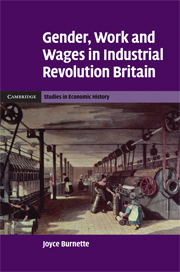Book contents
- Frontmatter
- Contents
- List of figures
- List of tables
- Preface
- Introduction
- 1 Women's occupations
- 2 Women's wages
- 3 Explaining occupational sorting
- 4 Testing for occupational barriers in agriculture
- 5 Barriers to women's employment
- 6 Occupational barriers in self-employment
- 7 Women's labor force participation
- 8 Conclusion
- Appendix to Chapter 3
- Appendix to Chapter 4
- Bibliography
- Index
Preface
Published online by Cambridge University Press: 07 August 2009
- Frontmatter
- Contents
- List of figures
- List of tables
- Preface
- Introduction
- 1 Women's occupations
- 2 Women's wages
- 3 Explaining occupational sorting
- 4 Testing for occupational barriers in agriculture
- 5 Barriers to women's employment
- 6 Occupational barriers in self-employment
- 7 Women's labor force participation
- 8 Conclusion
- Appendix to Chapter 3
- Appendix to Chapter 4
- Bibliography
- Index
Summary
Once upon a time women were largely missing from economic history. Economic historians somehow managed to make claims about the standard of living without examining women's wages. Happily, that has now changed, thanks to the efforts of pioneering feminists who made the case for the importance of including women in economic history. Since the value of studying women as well as men is now well established, I do not feel a need to justify the existence of this book. The subject matter is contentious, but it is my hope that the book will stimulate, not an all-or-nothing debate about the existence of gender discrimination, but a nuanced discussion of where, when, and how gender discrimination may have operated, and of the relationship between discrimination and markets.
This book began fifteen years ago as a PhD dissertation at Northwestern University. The origin of the project was a paper I wrote for Joel Mokyr's European Economic History class on the correlation between male and female wages in the “Rural Queries” of 1833. This paper got me thinking about how the labor market treated women, a process which eventually led to the ideas expressed here. I am grateful for the input of Joel Mokyr, my dissertation advisor, and Rebecca Blank and Bruce Meyer, the labor economists on my committee. A grant from the Mellon Foundation supported a year of dissertation research, and a Northwestern University Dissertation Year Grant supported the purchase of microfilm from the archives.
- Type
- Chapter
- Information
- Gender, Work and Wages in Industrial Revolution Britain , pp. xi - xiiPublisher: Cambridge University PressPrint publication year: 2008

